Key takeaways:
- Analytics provides crucial insights that guide decision-making and highlight opportunities for improvement.
- Identifying and utilizing Key Performance Indicators (KPIs) focuses efforts on meaningful metrics that drive team performance.
- Continuous improvement through regular monitoring, data organization, and A/B testing fosters adaptability and enhances overall effectiveness.
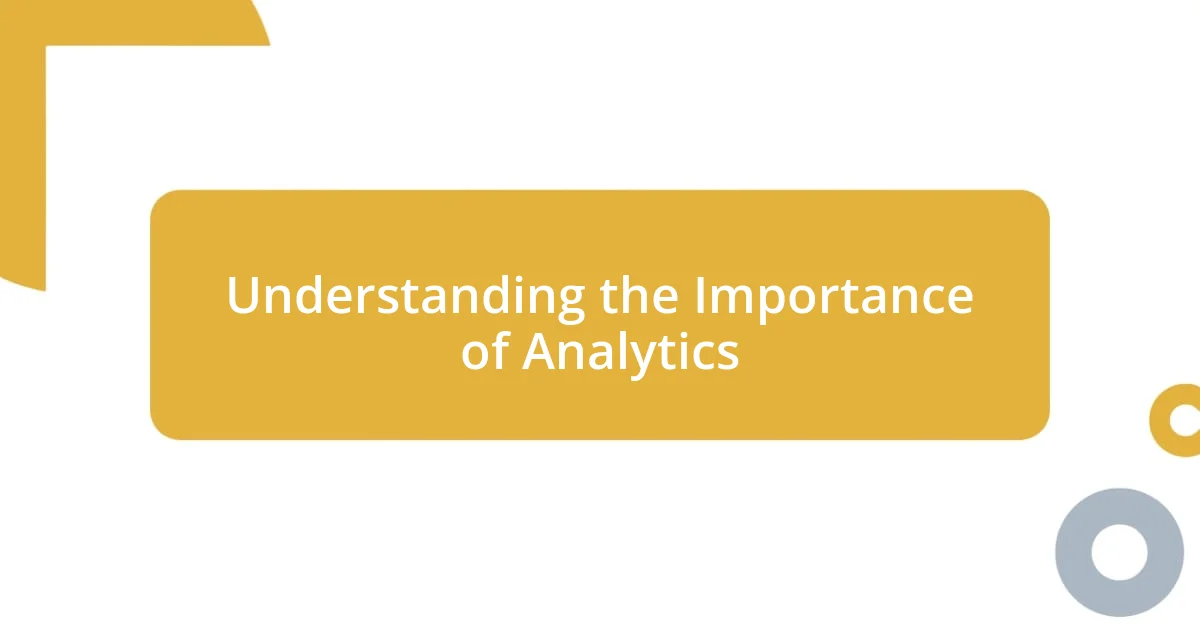
Understanding the Importance of Analytics
When I first started using analytics in my work, I was blown away by how much insight data could provide. I remember sifting through numbers and trends, realizing that I could pinpoint exactly where improvements were needed. It was like turning on a light in a dark room—suddenly, I could see opportunities that were previously hidden.
Analytics serves as a compass, guiding decisions that can significantly impact outcomes. Have you ever second-guessed a strategy only to find out later that the data was right? I certainly have. Analyzing metrics helped me understand not just what to do, but also what to avoid, leading to smarter, more calculated choices.
At its core, analytics is about storytelling through data. When I share data with colleagues, I often draw on real-life examples to show trends and patterns. The joy comes from transforming raw numbers into actionable insights, turning abstract figures into relatable narratives that spark conversations. Isn’t it fascinating how numbers can reveal hidden stories that drive our decisions?
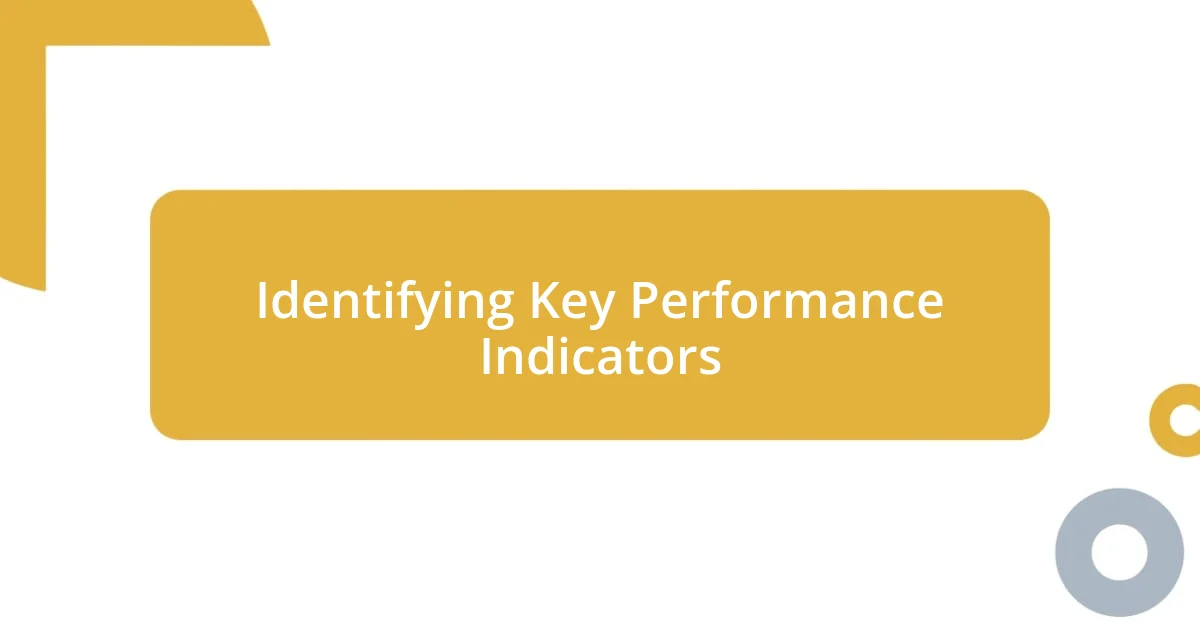
Identifying Key Performance Indicators
Identifying the right Key Performance Indicators (KPIs) is where the magic of analytics truly begins. I recall a project where I painstakingly formulated KPIs that aligned with our team’s objectives. It was enlightening to see how a well-chosen set of indicators could direct our focus and action. Not all metrics are created equal; I learned that the key is to select those that not only matter but also motivate the team to strive for improvement.
Here are some KPIs I consider crucial based on my experience:
- Customer Satisfaction Score (CSAT): Measures how satisfied customers are with our products or services.
- Net Promoter Score (NPS): Indicates customer loyalty and likelihood to recommend our offerings.
- Conversion Rate: The percentage of visitors who take a desired action, which helps gauge the effectiveness of our marketing efforts.
- Monthly Active Users (MAU): Tracks user engagement on digital platforms, giving insight into retention and user base growth.
- Revenue Growth Rate: Assesses the percentage increase in revenue over a specific period, highlighting financial health.
These KPIs have guided my team’s discussions, prompting exciting brainstorming sessions filled with possibilities and driven by real data. Each metric holds a story about our performance, revealing nuances that shape our strategies moving forward.
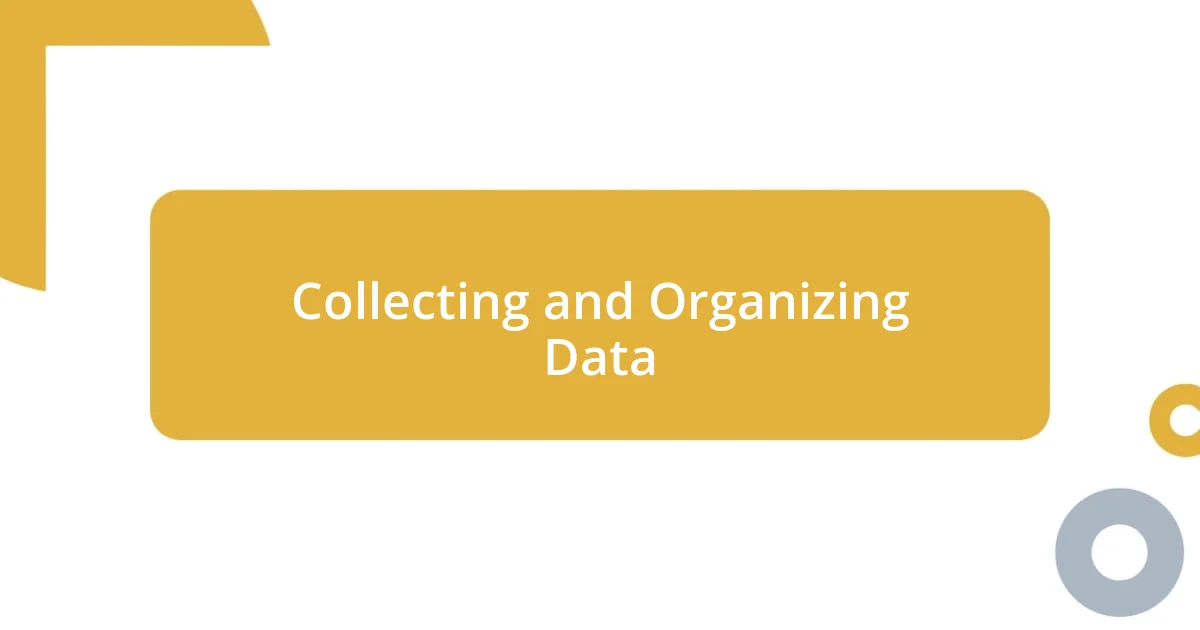
Collecting and Organizing Data
Collecting data effectively is where my analytical journey truly takes shape. I remember the first time I intertwined multiple data sources to build a comprehensive picture of performance. It felt like assembling a puzzle; every piece of data brought more clarity to the entire scene. Whether I’m utilizing customer feedback, web analytics, or sales figures, the richness of combined data helps me gain insights I wouldn’t achieve through standalone metrics. Have you experienced a “eureka” moment when integrating different data types?
Organizing that data is just as crucial as the collection process. I’ve often encountered cluttered spreadsheets that left me feeling overwhelmed. In my experience, creating a structured approach—like categorizing data by source or purpose—transforms chaos into clarity. A well-organized database not only speeds up analysis but also improves collaboration among team members. It’s rewarding to know that a few hours spent organizing data can yield days of insightful conversations later.
The integrity of the data I collect cannot be overlooked. I vividly recall a time when I discovered some of my customer data was inaccurate, skewing my findings. This taught me the importance of verifying sources and maintaining clean datasets. Protecting the quality of data is like safeguarding the foundation of a house; without it, everything is at risk. Adopting tools that regularly assess data quality has shown me the light as I strive for accuracy in analytics.
| Data Collection Method | Key Features |
|---|---|
| Surveys | Direct feedback from customers, customizable questions based on specific objectives. |
| Web Analytics | Tracks user behavior on websites, provides insights into audience engagement and conversion rates. |
| CRM Systems | Central repository for customer information, enhances tracking of interactions and sales. |
| Social Media Metrics | Analyzes engagement on platforms, reflects brand perception and effectiveness of campaigns. |
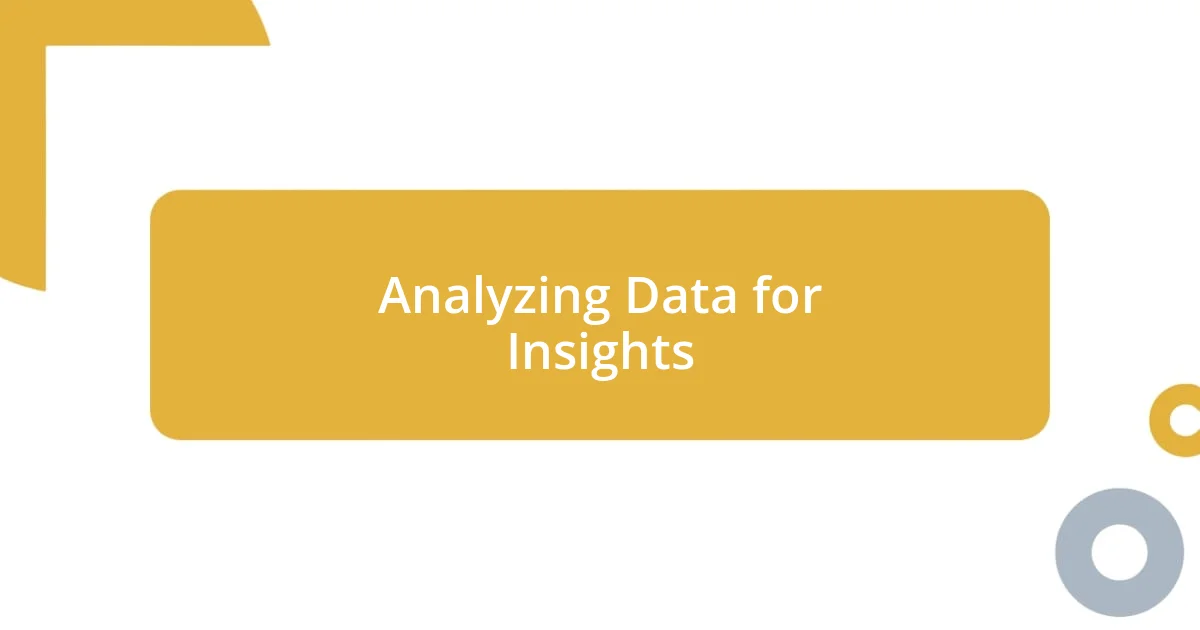
Analyzing Data for Insights
The process of analyzing data feels almost like stepping into a detective’s shoes—searching for clues to uncover insights that can drive decisions. I vividly recall a time when I dug deep into our customer satisfaction surveys, sifting through qualitative comments alongside quantitative scores. It was a revelation to connect the dots between the numbers and the heartfelt feedback, showing me issues we hadn’t even considered. Have you ever unearthed a surprising trend that reshaped your understanding?
In my experience, visualizing data plays a crucial role in extracting meaningful insights. I can’t stress enough how much I value tools like dashboards, where vivid graphs and charts tell compelling stories at a glance. One project stands out; we plotted our monthly sales against marketing spend, and the visual connection allowed us to see patterns faster than ever. It became clear that some months were golden while others barely shone, prompting discussions that led to strategic shifts.
Moreover, interpreting data requires a blend of intuition and analysis. I’ve learned to trust my gut when a number seems off or a trend doesn’t match expectations. A few months ago, I noticed a dip in our conversion rates—an instinctive alarm went off, compelling me to dig into the root causes. That deep dive revealed browser compatibility issues, which we promptly addressed, leading to a swift recovery. Isn’t it fascinating how sometimes our instincts guide us to insights that data alone might not highlight?
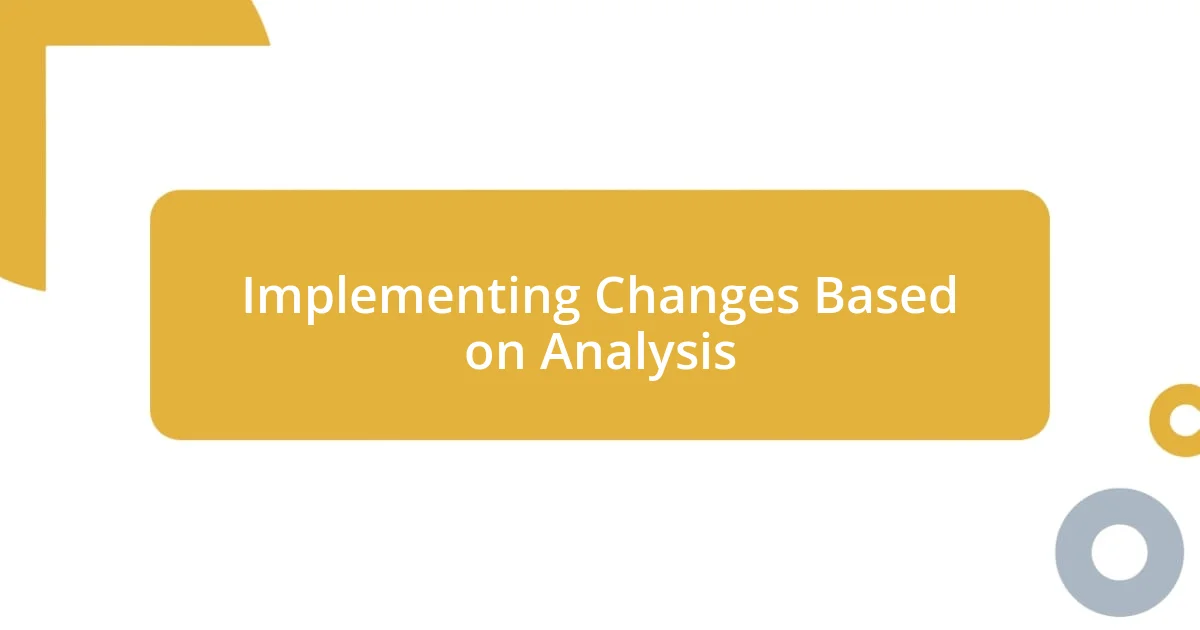
Implementing Changes Based on Analysis
Implementing changes based on analysis is an exciting yet challenging process. When I first recognized a drop in user engagement on our platform, I knew it was time to act. My gut told me that our content was stale, but the data confirmed it; after reviewing engagement metrics, we revamped our editorial strategy. The transformation was remarkable—within weeks, audience interaction surged, and our community felt more vibrant than ever. Don’t you find it exhilarating when changes lead to such immediate impact?
One of my favorite strategies is to prioritize feedback loops after implementing changes. Once we introduced a new feature based on user behavior analysis, I eagerly awaited customer responses. It was heartening to see a flood of positive reviews, but I also engaged with those who had concerns. Their insights became invaluable, enabling us to iterate further. This back-and-forth felt like a conversation with a friend, eager to help and guide us toward perfection.
I’ve learned that even small tweaks can yield significant results. Earlier this year, we tested adjusting our call-to-action buttons based on heat map data, which suggested areas where users hesitated. The moment we altered their color and placement, I noticed our conversion rates climbed, which made me reflect on how minor adjustments can lead to substantial outcomes. Have you ever felt that rush of recognition when something so simple changes the game? I certainly have, and it continually inspires me to stay curious and proactive in my analytical journey.
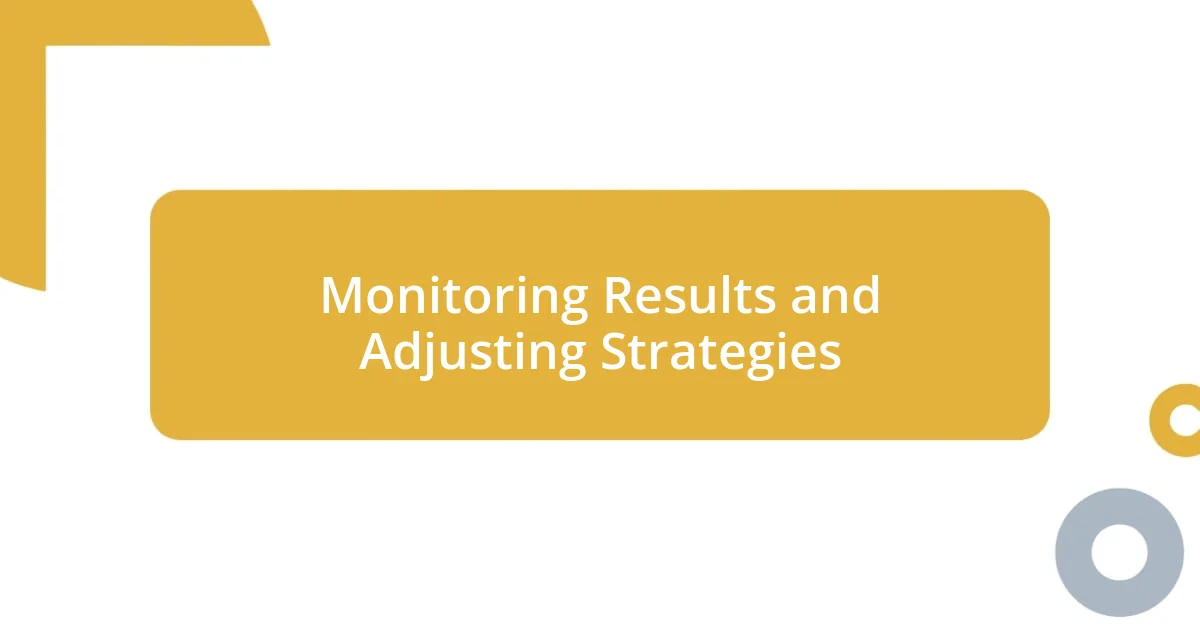
Monitoring Results and Adjusting Strategies
To effectively monitor results, I often set up regular check-ins that serve as a mini-pulse test for our initiatives. I recount a recent scenario where I earmarked Thursdays for a thorough review of our social media metrics. This routine not only keeps the data fresh in my mind but also allows me to spot trends quickly. Have you ever felt like you’re in a race against time with data? I know I have, but these check-ins give me the edge.
As I analyze the results, I think adjusting strategies is vital in maintaining a competitive edge. For example, when one of our campaigns underperformed, I took a cue from our engagement data, which indicated specific demographics that weren’t responding as we hoped. It was a bit disheartening, but I realized that instead of moving on, we could pivot—tailoring our content to better fit that audience. It’s fascinating how these adjustments can breathe new life into a project, don’t you think?
I’ve also learned that flexibility is key in this ever-evolving landscape. There was one instance where we observed an unexpected spike in mobile traffic. Initially, we didn’t capitalize on this trend, thinking it was just a blip. However, after closely monitoring the data over a few weeks, I pushed for a mobile-first approach in our next strategy meeting. Sure enough, this shift not only improved user experience but led to our most significant engagement uptick of the year. Reflecting on this reminds me how agility in our analytic processes can open doors we never knew existed.
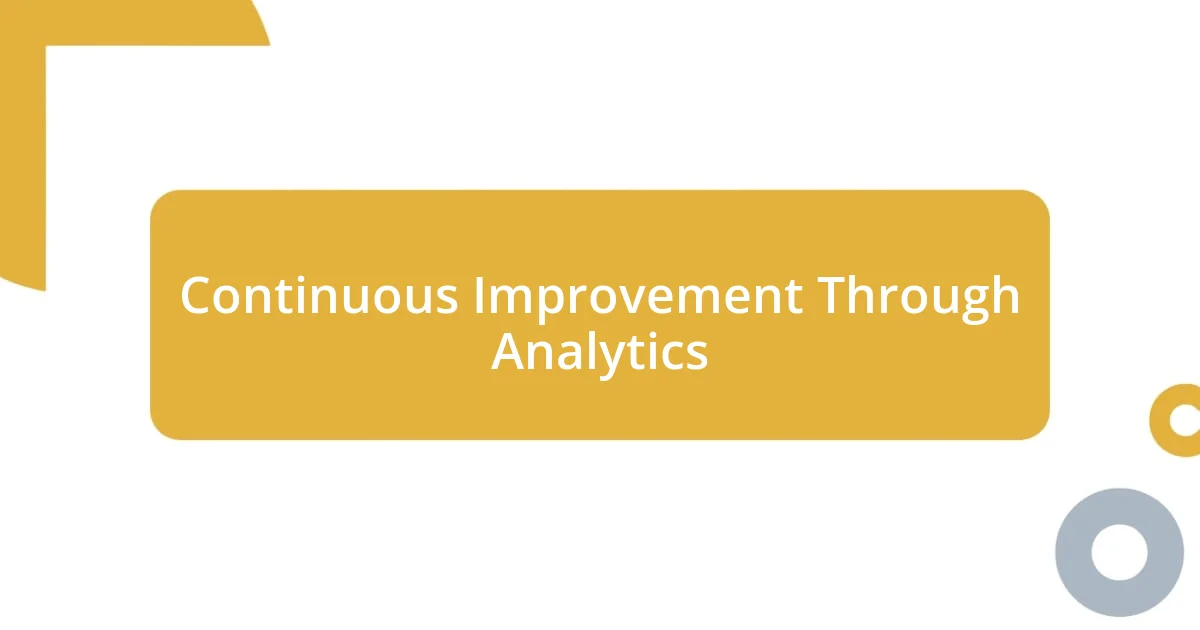
Continuous Improvement Through Analytics
Continuous improvement is at the heart of how I leverage analytics. Recently, I noticed an opportunity while reviewing our website’s bounce rates. The data showed users were leaving swiftly, suggesting they weren’t finding what they needed. This sparked my curiosity and led me to dive deeper, ultimately discovering that clearer navigation could enhance user retention. Isn’t it amazing how data can guide our instincts toward tangible solutions?
Another experience that stands out is when I realized our email open rates were stagnating. I decided to segment our audience more precisely and tailored content to resonate with each segment’s preferences. The outcome was mind-blowing; our open rates leaped by 40%. This taught me that personalization, backed by solid analytics, can forge stronger connections with our audience. Have you ever struck gold by simply refining your approach? It’s moments like these that fuel my passion for continuous improvement.
I also believe in the power of A/B testing. Just last month, we experimented with two different landing page designs, driven by user interaction analytics. It was thrilling to witness real-time results as one design significantly outperformed the other. The excitement of seeing our hypotheses validated in the data is exhilarating. It reminds me that each experiment is a step forward, and every piece of information carried is a chance to enhance our efforts. How often do we embrace experimentation in our processes? I urge you to take that leap; it can lead to incredible breakthroughs.














